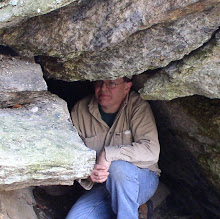I've had a project hanging around for the past five years over in the southern Quabbin Reservoir region and things looked good to make it happen! A small (VERY small) cave was discovered there. But of greater interest was a set of initials/names that had been carved on its walls and dated 1878. Some research from an existing photo led to the possibility that at least one of the individuals responsible was a previous landowner!
But let's not get ahead in this story! I started the day looking up the local stone chamber (occasionally called Monk's Caves) which I last visited in 2009. I tried to access the site back in 2015 but the area is covered by dense underbrush. Mostly of a very thorny variety. It never happened on that day and I moved on to another small cave. But the present time brought me back to the area hoping that with the foliage not yet in bloom, I might yet reach the chamber. The short version of this story is I did finally get there! But at the cost of plowing through a considerable forest of prickly growth. I was shocked upon arrival to see the chamber's exterior completely engulfed by the growth and only recognizable from a few feet away. Time was spent gathering a new set of photos and seeing little (at least on the inside) had changed over the past 11 years. I did not relish the thought of traversing the prickly forest once again to make my exit but luck was with me. About a third of the way out to the trail, I came upon an area that was somewhat more open than thorn covered vines. Success!
Moving on, I arrived at the parking area for the large react of land I would have to cross to hopefully reach my destination. The site had been successfully located - and explored - late last year by eminent explorer Mike "Rhody Mountain Man" G. It would be impossible to overestimate how much 'easier' that would make my trip. A long walk later - only to find I had incorrectly entered GPS data - I made the necessary adjustment and finally arrived at the cave. It is a curious item. The ledge had been obviously shaped by the forces of weathering with a large talus slope out in front supplied by the disintegrating rock. But of greater geologic interest, was the appearance of possible solutional formation of the tiny cave. So I set about running quite a few tests with my bottle of acid. Initially, I got all negative results. But before leaving the scene, I went deeper into the cave and tested a number of locations along its walls. Positive! Even though I was able to get a pretty good fizz at one location, and a lighter reaction on the opposite wall, this confirms the presence of carbonate rock. And the possibility this cave was a lens dissolved out of the parent rock.
At this point, it was time to call it a day! I drifted down to the Turnpike and back west to the Berkshires.











